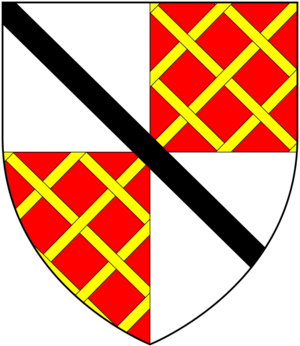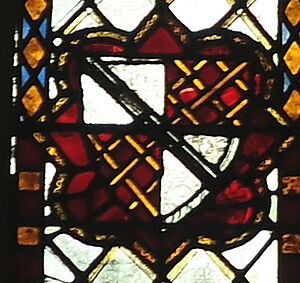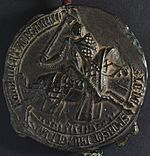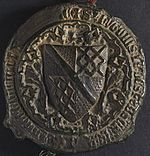Hugh le Despenser, Baron le Despenser (1338) facts for kids
Quick facts for kids
Hugh le Despenser
|
|
|---|---|
| Baron le Despenser | |

Arms of Despenser
|
|
| Predecessor | Hugh Despenser the Elder |
| Successor | Edward Despenser |
| Other titles | Lord of Glamorgan |
| Other names | Huchon Despenser Hughelyn Despenser |
| Born | c. 1308/9 |
| Died | 8 February 1349 |
| Buried | Tewkesbury Abbey, Gloucestershire, England |
| Wars and battles | Second War of Scottish Independence Hundred Years' War War of the Breton Succession |
| Spouse(s) |
Elizabeth Montague
(m. 1341) |
| Father | Hugh Despenser the Younger |
| Mother | Eleanor de Clare |
Hugh le Despenser (born around 1308 or 1309 – died February 8, 1349) was an important English nobleman. He was also known as the Lord of Glamorgan. Hugh was first put in prison because he supported King Edward II, who was removed from the throne. Later, he returned to favor with the next king, Edward III. In 1338, he was given the title of Baron le Despenser. He had no children, so his title ended when he died.
Contents
Hugh's Family Background
Hugh was the oldest son of Hugh Despenser the Younger. His grandfather was Hugh le Despenser, 1st Earl of Winchester. Both his father and grandfather faced serious consequences in 1326. At that time, young Hugh was about 18 years old.
His mother was Eleanor de Clare. She was the 6th Lady of Glamorgan in her own right. Eleanor was the daughter of Gilbert de Clare, 6th Earl of Hertford and Joan of Acre. Joan of Acre was King Edward II's sister, making Hugh a relative of the king.
Hugh's Life and Work
In 1326, King Edward II, who was trying to escape, told Hugh to take control of lands belonging to Henry, Earl of Lancaster. Hugh also helped the king by defending Caerphilly Castle for a long time. He fought against the forces of the queen, Queen Isabella.
He finally gave up the castle in 1327. He was promised that his life and body would be safe. After this, Hugh was put in prison until 1331. He spent some of this time in Bristol Castle.
In 1330, Edmund, Earl of Kent, named Hugh as someone who had worked with him. After King Edward III became old enough to rule on his own, he took power from his mother's group. Hugh was then set free. The king gave him lands and money worth 200 marks each year. In 1332, Hugh went on a special trip to Santiago de Compostela.
Becoming Lord of Glamorgan
In 1337, Hugh took over his mother's lordship of Glamorgan. He also fought in the Scottish Wars in both 1337 and 1338. In 1338, he was called to important Royal Councils. In the same year, he was called to Parliament. This meant he became Baron le Despenser with a new title. This was important because his father's and grandfather's titles had been taken away.
Fighting in Wars
Hugh continued to serve the king in battles. He fought at the Battle of Sluys in 1340. He also fought in Brittany and at the Battle of Morlaix in 1342. He was a banneret, which was a high rank for a knight.
In 1346, Hugh went with King Edward to France. He was part of the king's group at the famous Battle of Crecy. The next year, the king called him to the siege of Calais.

Hugh's Family and Death
By April 1341, Hugh had married Elizabeth Montagu. She was the daughter of William Montagu, 1st Earl of Salisbury and Catherine Grandison. Elizabeth had been married before to Giles, Baron Badlesmere.
Hugh and Elizabeth did not have any children together. Hugh died on February 8, 1349. He was buried at Tewkesbury Abbey in Gloucestershire. Because he had no children, the title of Baron le Despenser that was created for him ended.
His nephew, Edward Despenser, took over his lands. Edward was later given the title of Baron le Despenser in 1357, but it was a new creation. Hugh's wife, Elizabeth, married again to Sir Guy, Baron Briene. She died in 1359 and was also buried at Tewkesbury Abbey.



